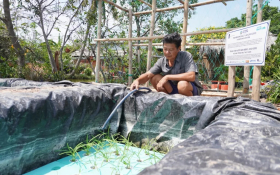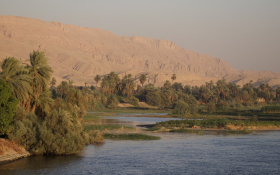A Sea Fort for Jakarta
Tempo Magazine, Jakarta - 09/03/2011
Jakarta plans to build a sea embankment to follow in Holland’s footsteps. It will change the face of Jakarta Bay.
Without rain and wind, Pasar Lama Muara Baru, North Jakarta, remains inundated daily from around 6am to 10am. When the weather is sunny, water is ankle-deep. But when it rains with strong wind, the inundation can be 80 centimeters in height, spreading as far as settlements and the northernmost fish port of Nizam Zachman.
Seawater floods in along with the rising tide as the zone in Penjaringan district is almost at the same level as the water of Jakarta Bay. The land and the sea are separated by a concrete dike to the height of an adult’s chest. Failing to penetrate the dike, water infiltrates the land through gutters.
According to Casman, 36, tidal floods have become a daily experience of Muara Baru people over the past five years. “Earlier we never heard of such floods known as rob,” said the resident, who has since 1996 lived in RT 17-RW 16 neighborhood unit.
The inundation creates some problems.
The port has mixed odors, ranging from those of rotten fish, salted fish, to excrement. The salt water infiltration makes residents do a special ritual after washing their vehicles: smearing all metals with oil to guard against rust. The biggest problem is certainly the recurring floods during downpours and high waves.
In the northern part of Jakarta, the soil indeed seems to subside faster. An expert from Bandung’s Institute of Technology (ITB) records 5-10-centimeter land subsidence per annum. ITB geodesy researcher Heri Andreas said the land is now lower than 36 years ago, with an ever more rapid sinking rate to the north. It shrinks from 0.25 meters in Cibubur, 0.8 meters in Cikini, 1.55 meters in Cempaka Mas, to 2.55 meters in Cengkareng. In Muara Baru it even registers 4.1 meters. As a whole, according to him, 40 percent of Jakarta lies below sea level.
The subsidence, added Heri, resulted from unlimited underground water suction. The other causes include the load of buildings and the natural process of soil compression. But the latter two factors are only a matter of millimeters per annum.
The shrinking land poses Jakarta a greater threat than the rising sea level due to global warming. Heri said thanks to its location a long way from the source of melting polar ice, the Jakarta Bay water had only risen 5 millimeters annually, below the world coastal city average of 1-2 centimeters. “As proof, all coastal cities face sea-level rises but not all have tidal floods,” he noted.
To prevent Jakarta from drowning, in October Governor Fauzi Bowo set up the Jakarta Coastal Defense System (JDCS), a consortium comprising representatives from a Dutch technical consulting firm and ITB. The idea of turning North Jakarta into a water reservoir was proposed, which prompted the consortium to focus on damming the sea, as was affirmed by a note of understanding signed with Rotterdam early this month. The choice is between building a dam on the beach and in the sea.
Fauzi closed the doors to the first.
The reason: if the dam is located on the beach, Jakarta with its 13 rivers needs a 100-square-kilometer reservoir to collect water before being pumped to the sea. The area is almost as big as North Jakarta.
The reservoir can be reduced by half. But this needs pumps with a capacity of 500 cubic meters per second. In fact, the world’s largest pump in New Orleans (USA) and Egypt only has a capacity of about 400 cubic meters per second. “The land isn’t available, neither are the pumps,” said Fauzi.
The other more affordable option is to build a giant dam in Jakarta Bay. In this way, a water reservoir will be created between the land and the dam.
To this end, Fauzi is using Holland as the example. Besides for their own country, Dutch engineers have built dams in nearly all coastal cities around the world, from St Petersburg (Russia) to Singapore. Jakarta also has twin-city cooperation with Rotterdam for water management study. Rotterdam lies 6 meters below sea level. However, thanks to the dams spanning the western side and facing the Atlantic Ocean, also on the bed of Rotte River, the city is always dry.
The size, location and shape of the Jakarta sea fort are not yet determined as the consortium is in the phase of problem formulation. But by imitating the technology in Holland, the inner part of the dam will be composed of sand and earth. “It will be dredged from the sea and carried by ships,” said Sawarendro, representing Bos Witteveen, the Dutch construction company that built the New Port of Rotterdam, the largest in Europe. The outer part will bear stones, with a slope ratio of 1:7, one vertical to seven horizontal.
If built at a depth of 8 meters, the height of the dam will be about 6 meters. But if it’s farther out in the sea at a depth of 16 meters, the height should be 8 meters to hold back the larger waves. In the Netherlands, the sea embankment is 50 meters wide and it functions as a road.
Fauzi wants more.
He wishes to make the dam habitable. “So we can have an additional area for expansion,” he said. He referred to the Port of Rotterdam moved from the coast to the sea, linked with the dam. The old port has become a commercial zone.
Sawarendro said the dam would be built along with reclamation projects. Reclamation allows extra space for water management. The dam can be constructed from Kamal at the western tip of Jakarta to Marunda at the eastern tip, like an overturned bowl. The exception is Tanjung Priok Port, which is not to be disturbed, as Fauzi instructed.
When Tanjung Priok’s expansion—planned to reach the upstream area of Kanal Banjir Timur bordering Bekasi—is carried out, it will be enough to build the dam between Kamal and Tanjung Priok. It’s because the new port, to be named Ali Sadikin Port, will be set up at a height elevated enough to ward off seawater.
Dams are not the only solution to rid Jakarta of floods.
The land will continuously be eroded as long as its water is being removed. Osaka, Japan, succeeded in ending land subsidence by forbidding its residents from pumping out its water in 1970. Fauzi is pessimistic about banning 8.5 million Jakartans from using jet pumps or drawing well water. He adopts another way to reduce underground water suction: building a clean water installation at Jatiluhur Reservoir, West Jawa, and channeling the water through pipes along 70 kilometers to Jakarta. This system is expected to be operational within three years.
Citizens pin their hopes on this effort as a permanent solution to the flood problem in Jakarta—craved as long as 95 years ago by Mohammad Husni Thamrin, a member of the Dutch East Indies People’s Council. Fauzi selects it as the only choice.



